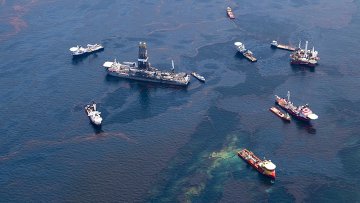Engineers at BP's disaster well in the Gulf of Mexico Friday moved one stop closer to full shut-down of the well after lifting off a key piece of the ruptured well head, dpa reported.
Thad Allen, the retired Coast Guard admiral in charge of the crisis, said that the damaged blow-out-preventer (BOP) had been lifted from the top of the well.
It would take another 24 to 36 hours to lift it to the surface from the ocean floor, Allen said. The well head is 1.5 km below the surface. Along with a latching device, the BOP weighs 450,000 kg.
The malfunctioning BOP is blamed for contributing to the April 20 explosion that ruptured the well head and unleashed crude oil into the Gulf of Mexico for three months. It was the worst oil spill in US history.
Since mid-July, the flow has been stemmed through a series of measures that included a final cementing process last month.
A new blow-out preventer is to be installed in place of the damaged one as an added back-up to the cement and mud now plugging the well.
After that, the full close-down of the well will be done through the so-called bottom kill procedure, possibly as early as next week. The bottom kill entails pumping cement into the bottom of the well through a relief well drilled especially for that purpose.
The BP well leaked about 4.9 million barrels of oil into the Gulf, and spawned underwater oil plumes that scientists are still studying. Much of the oil was collected by skimming and burn-offs.
The coasts of Louisiana, Mississippi, Alabama and Florida are still reeling from the ecological damage to fragile coastal lands. BP has committed to a 20-billion-dollar clean-up and damage fund to compensate for damage to the economy and the environment.
The US government has gradually reopened parts of the large area of the Gulf that was shut down for fishing out of concern for the safety of the food. At the height of the crisis, in June, 37 per cent of federal waters were closed for fishing. As of Friday, that closed area had been reduced to 17 per cent of federal waters, the National Oceanographic and Atmospheric Administration said.






